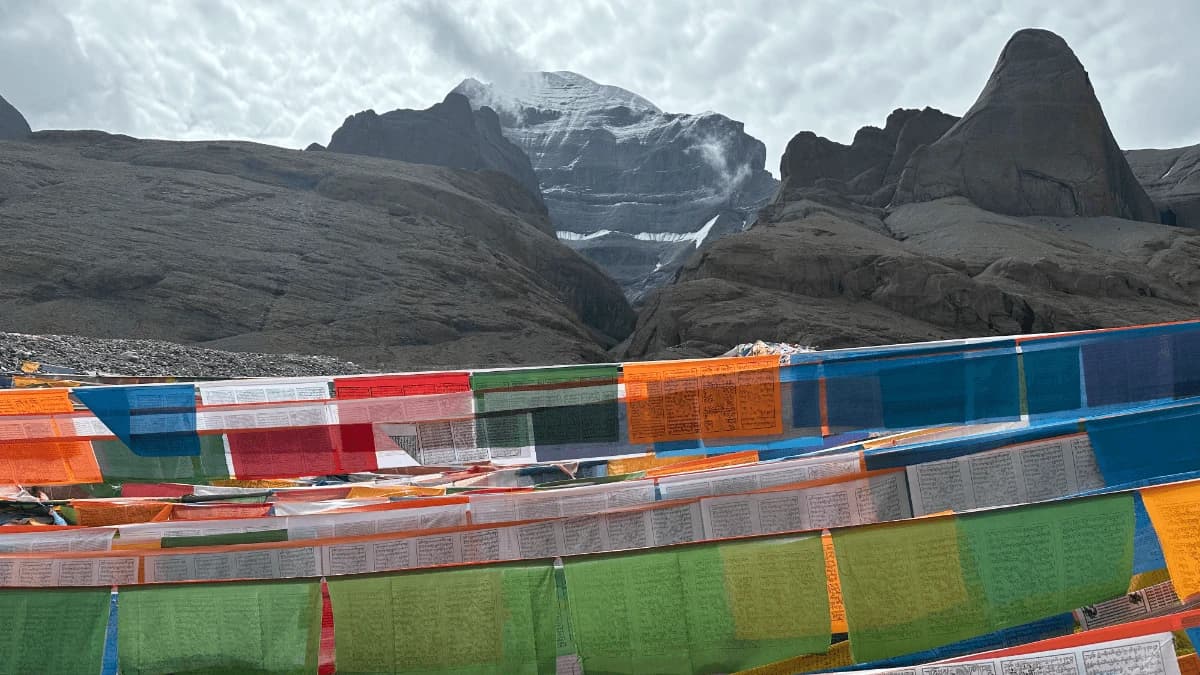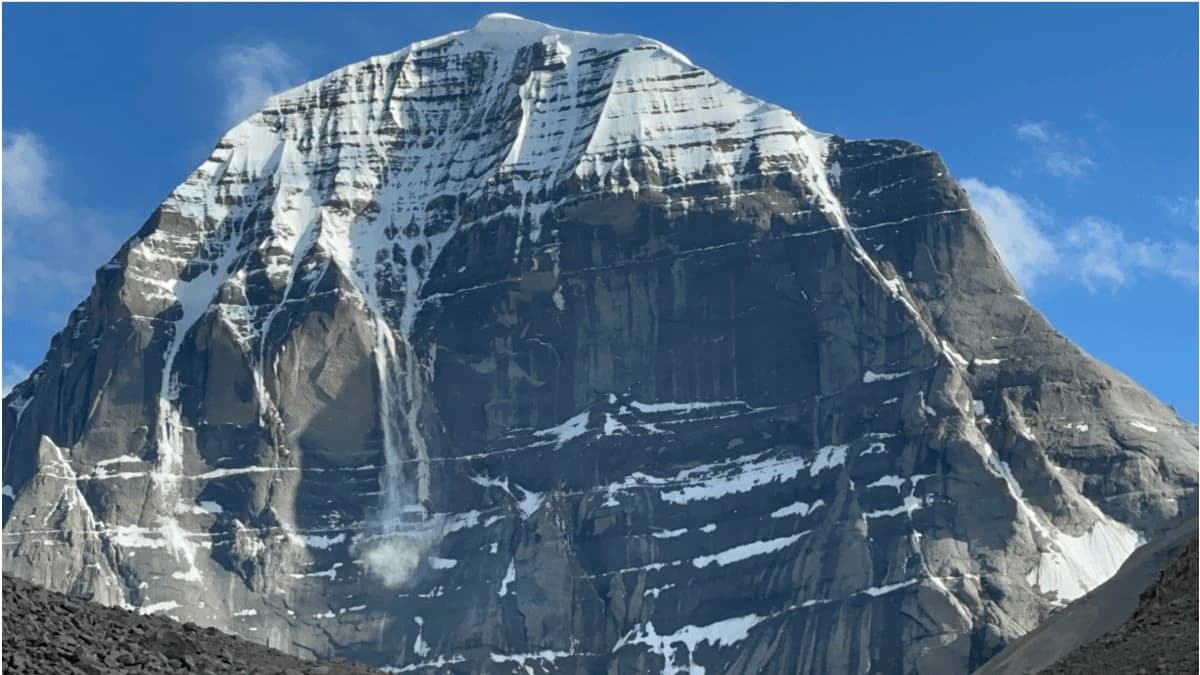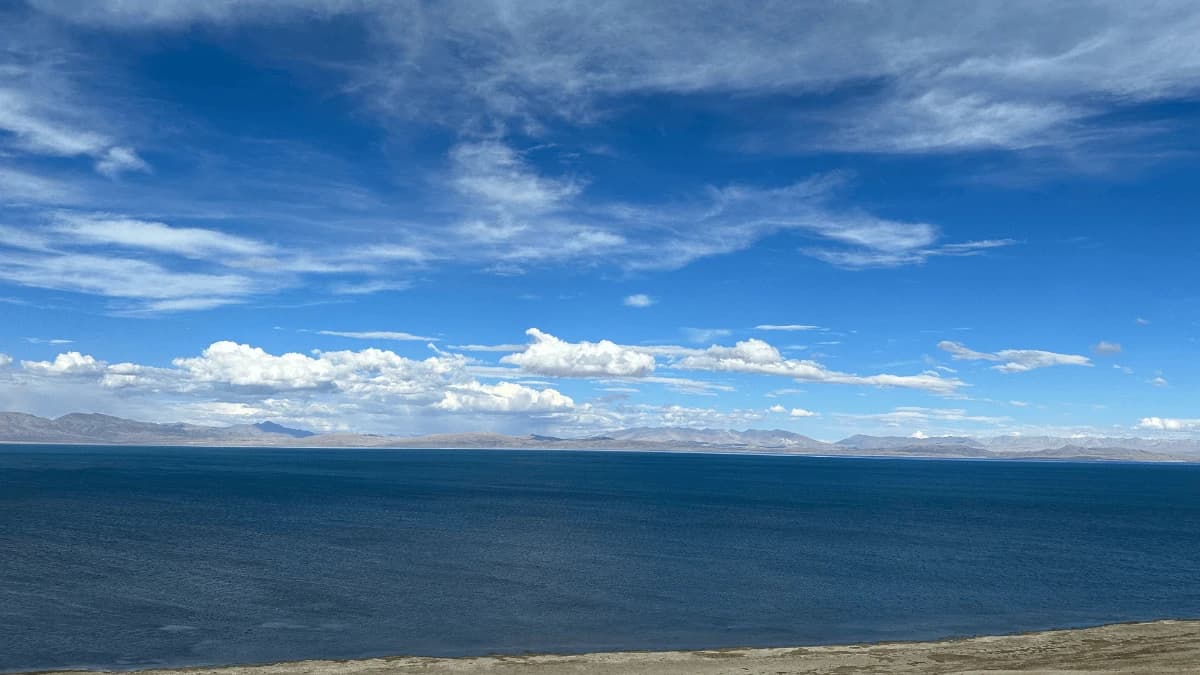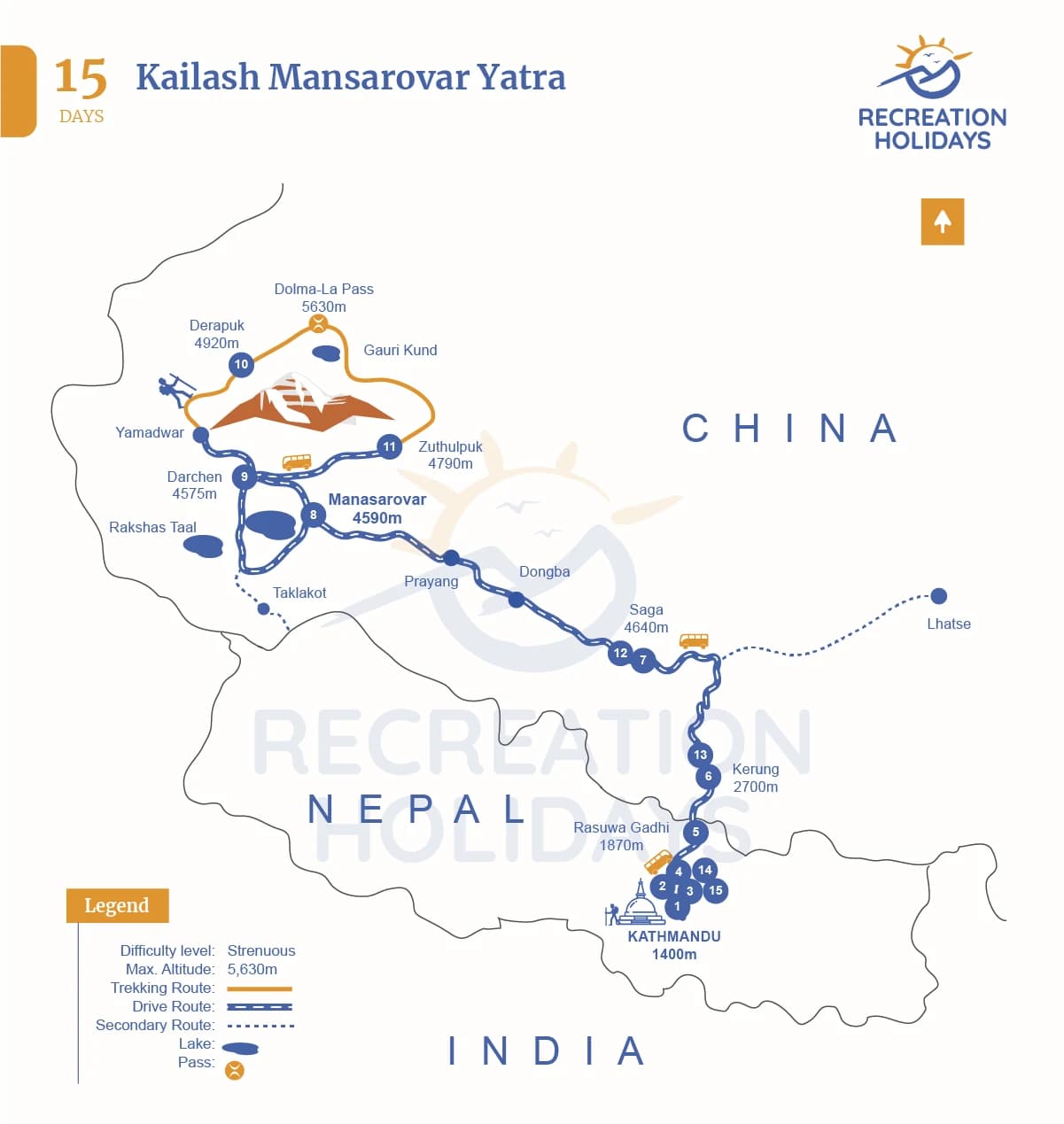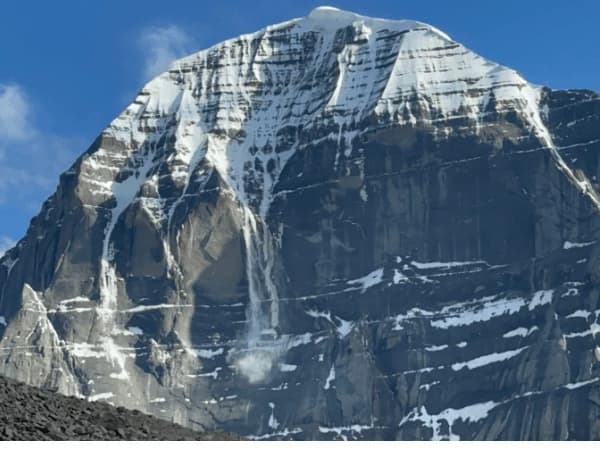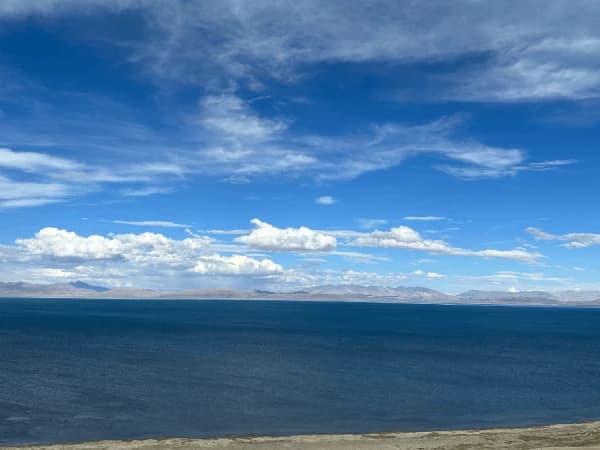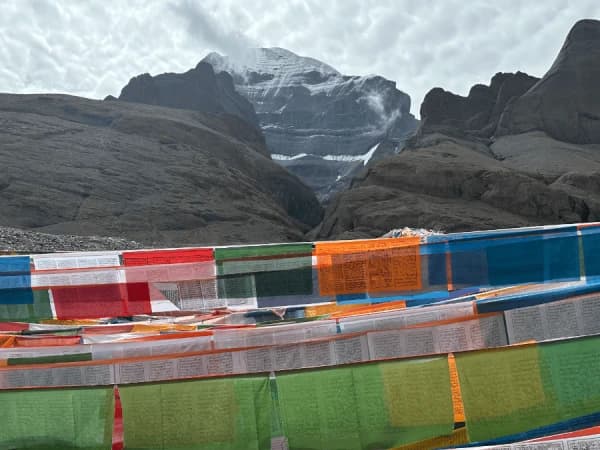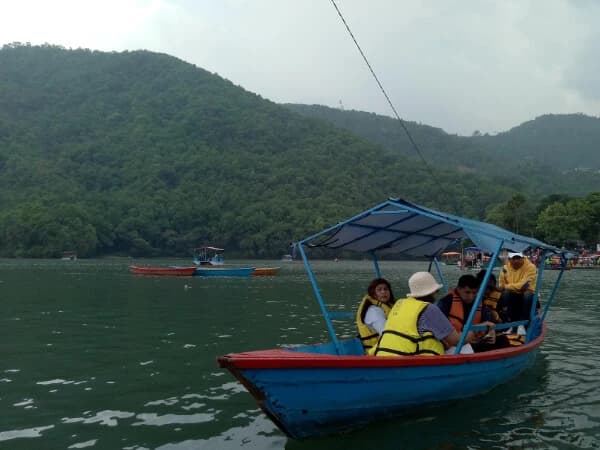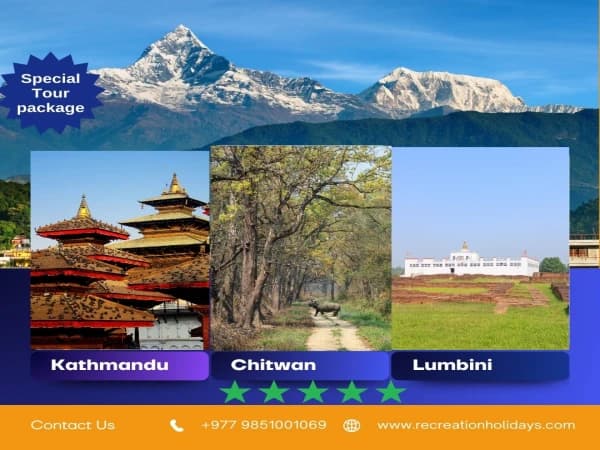Kailash Mansarovar Yatra 2026 is a journey of divinity to be undertaken once in a lifetime for spiritual awakening and deep inner peace. Recreation Holidays has tailored an economical package for the well-organized Kora trek with trusted service and care.
Kailash Mansarovar Yatra 15 Days Package
Highlights of the Kailash Mansarovar Yatra
- Full day sightseeing of the world heritage sites in the Kathmandu Valley and nearby areas, which includes Pashupatinath Temple, Swayambhunath Stupa, Boudhanath Stupa, Kathmandu Durbar Square, Bhaktapur Durbar Square, and Patan Durbar Square.
- Enjoy the amazing landscapes, greenery during the thrilling drive towards the Kerung border, heading to Tibet for Kailash Mansarovar Yatra by road
- Grasp the golden chance of exploring the ancient monasteries exhibiting the authentic Tibetan culture and have fun meeting the locals during Mount Kailash Mansarovar Yatra
- Feel the spiritual vibes of the Kailash Mansarovar Yatra with the closer views of Mount Kailash and Lake Mansarovar.
- Visit the beautiful 13-Golden Chortens and the Saptarishi Cave.
- Good preparation for acclimatization in higher altitudes to conquer the harsh climate of the Mount Kailash journey
- Soak yourself in the divinity of the stunning Himalayan scenery, high deserts, and turquoise lakes of the Mount Kailash region
- Experience the spiritual accomplishment and peace on completing the Kailash Kora, which helps maintain a balance between your physical and mental life. The exclusive Mount Kailash Mansarovar Yatra - inner peace
Kailash Mansarovar Yatra with Kora is one of the most revered and transformative pilgrimages in the world. Thousands of devotees and spiritual travelers every year undertake this wonderful and long journey for inner peace, spiritual attainment, and communion with nature. The yatra revolves around Mount Kailash, which is considered the holy abode of Lord Shiva, and Lake Mansarovar, one of the highest freshwater lakes in the world. And anywhere between 10 and 15 days, according to the route, whether from Nepal (Simikot or Kerung) or directly through Tibet.
The highlight, however, is the Mount Kailash Kora—a 52-kilometer kora that encircles the holy mountain for about 2-3 days. The undertaking is a spiritual walk to purify sins and move closer to moksha (liberation). The high point and most difficult cross of this Mount Kailash Mansarovar Yatra is Dolma La Pass (5,630 meters), making up for both a spiritually powerful and physically demanding trek. Because of the altitude and the constant change of weather, acclimatization and being in shape are really very important.
From May through September, the best time for Kailash Mansarovar Yatra is when the weather is more stable and the views of the Himalayas become truly beautiful. The Kailash Mansarovar Yatra route begins either in Kathmandu, Nepal, or Lhasa, Tibet. Gradually, the views change from the bright and green hills to snow-covered peaks and finally to wide, open Tibetan plains.
This Kailash Mansarovar Yatra 15-day is more than just a trek. It is probably tied to the deepest spiritual meaning. Mount Kailash is said to be sacred for Hindus, Buddhists, Jains, and even devotees of Bon, making it a different interfaith pilgrimage. A dip in Lake Mansarovar is believed to purify the soul and wash away its sins, contributing to the spiritual efficacy of the journey.
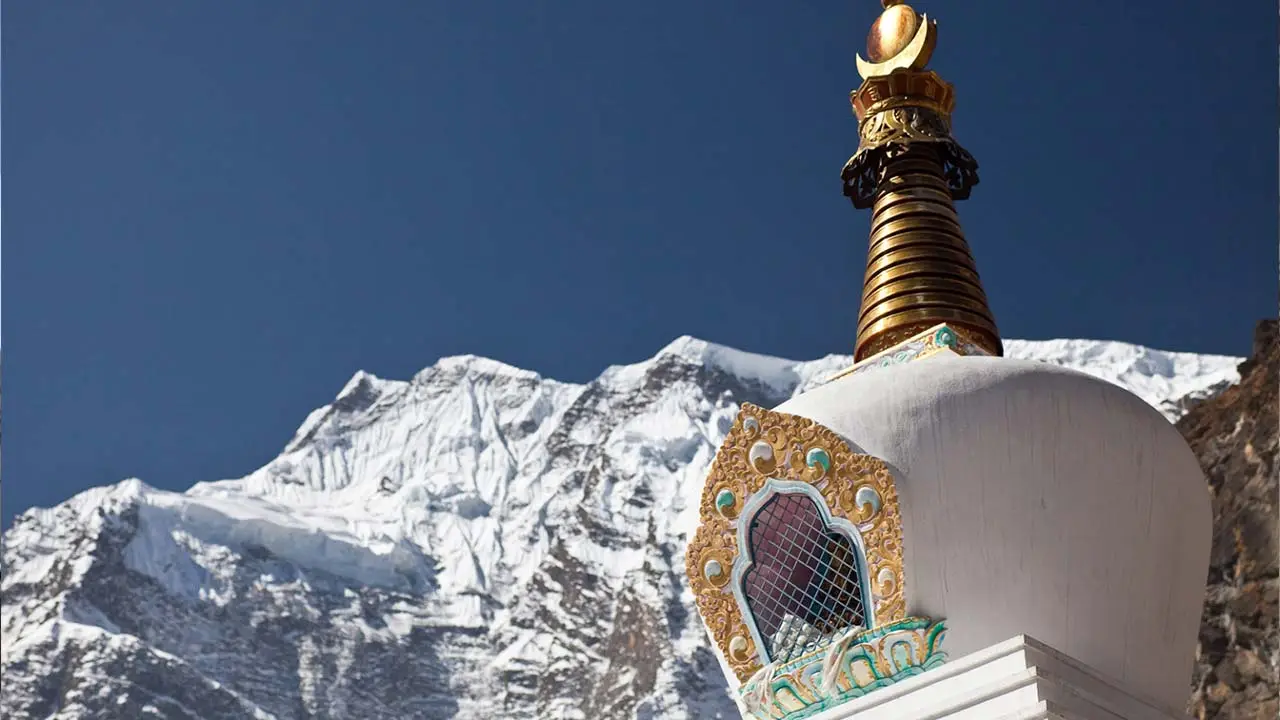
Main attractions of this include Mount Kailash itself (6,638 m), the calm Lake Mansarovar (4,590 m), the strenuous Dolma La Pass, and sacred places like Yam Dwar, Dirapuk Monastery, and last but not least, Zuthulpuk Monastery. The Kora trail is strewn with visionary mythological spots like Gauri Kund, Shiva Tsal, and Ashtapad, where Lord Shiva is said to meditate forever. This Kailash Mansarovar Yatra by road for a 15-day package is a potent mix of adventure, devotion, and self-discovery, making it a must for the spiritual seeker as well as the outdoorsman. Now, better infrastructure and organized tours have brought this trek as Kailash Mansarovar Yatra package to be counted among the most treasured and sacred high-altitude treks in the world: Kailash Mansarovar Yatra with a Kora.
Conclusion: The 15-day Kailash Mansarovar Yatra combined with Kora is a transformative adventure of soul, spirituality, and nature as seen in Nepal and Tibet. The pilgrimage, happening once in a lifetime, entails the inner peace accompanying the sacred parikrama around Mount Kailash as well as the divine aura of Lake Mansarovar. Book your 2026 Kailash Yatra package now for a safe, guided, and transformative journey with Recreation Holidays.
Kailash Mansarovar Yatra 15 Days Package Itinerary
Detailed Itinerary of Kailash Mansarovar Yatra - A sacred spiritual journey to the abode of Lord Shiva
You will be greeted by a representative from Recreation Holidays, who will be waiting for you at the arrival point of Tribhuvan International Airport. You will then be transferred to the designated hotel in Kathmandu. After you freshen up, we will meet again for a brief about the Kailash Yatra. Enjoy the first arrival day and rest. If you are up for some exploration, you can roam around Thamel for essentials and souvenirs.
Meals: Dinner
Overnight: Hotel in Kathmandu
The representative will collect your original passports to submit for the Chinese Group Visa. After breakfast, you can go for a light shopping trip if you need any trekking items, such as warm clothes, trekking gear, or equipment, and snacks. We offer you the option to visit Boudhanath or Swayambhunath Stupa to experience and deepen your spiritual connection. By evening, a brief group orientation was held on altitude sickness, precautions to take, and emergency management.
Meals: Breakfast, Lunch, Dinner
Overnight: Hotel in Kathmandu
Today is a special visit to Pashupatinath Temple in the early morning, a holy Hindu temple for Lord Shiva, listed in the UNESCO World Heritage Sites. There will be a special puja (Aarati) ritual in the Pashupatinath Temple, which you can participate in and receive blessings. A short tour to explore the temple complex and the nearby Ghats of Pashupatinath temple. We can attend the evening Aarati as well, which is done near the sacred Bagmati river – a spiritual event with chants, lamps, and rites.
Meals: Breakfast, Lunch, Dinner
Overnight: Hotel in Kathmandu
After taking a hefty breakfast, we will head towards Bhaktapur and Patan Durbar Squares. These historical places are renowned for their cultural display, architecture, and traditions preserved since the medieval period. The famous highlights of Bhaktapur Durbar Square are the 55-Window Palace, Nyatapola Temple, and Dattatreya Square. Likewise, Krishna Mandir and rich artisan culture are the attractions of Patan Durbar Square. We will take you to either a traditional Thangka painting school or a metal craft workshop to spend some time on arts and crafts. By evening, you will be dropped back at the hotel and be prepared for the journey to Tibet.
Meals: Breakfast, Lunch, Dinner
Overnight: Hotel in Kathmandu
Start of the amazing Kailash Mansarovar Yatra. We’ll set out early in the morning for a drive to Rasuwagadhi or Syabrubesi, covering roughly 140 kilometers over 7 to 8 hours. The road winds through lush hills, alongside rivers, and past charming mountain villages like Trishuli and Dhunche, making the journey as memorable as the destination. On arrival at Rasuwagadhi, we’ll check into a basic lodge near the border. The evening is yours to relax and recharge in preparation for tomorrow’s border crossing.
Meals: Breakfast, Lunch, Dinner
Overnight: Lodge in Rasuwagadhi or Syabrubesi
We will travel to the border between China and Nepal after breakfast. You will enter the Chinese side after completing all immigration procedures on both sides, where your Tibetan guide and car will be ready to greet you. It is roughly around two hours' drive to reach the beautiful Kerung in the car.
From there, it’s roughly a two-hour drive to reach the town of Kerung. In the afternoon, we’ll take a short acclimatization hike to help your body adjust to the higher altitude.
Meals: Breakfast, Lunch, Dinner
Overnight: Hotel/Guesthouse in Kerung
We will start driving through a picturesque landscape of Tibet for around 6 to 7 hours, traversing high mountain passes such as Lablung La, seeing traditional nomad camps and grazing yak herds. On route, we’ll take some brief rest stops where you can take photos and enjoy some snacks. When we arrive in the Saga town at high altitude with a rest day to acclimatize, you will check into a hotel and rest and revitalize after the travel.
Meals: Breakfast, Lunch, Dinner
Overnight: Hotel in Saga
From Saga, the scenic drive to sacred Lake Mansarovar is an unforgettable one with some stunning views of the rugged Tibetan terrain and some distant views of the majestic Himalayas. And as you journey through the stretching Barkha plain, most westerners will be amazed at their first sight of Mount Kailash, the blessed domain of the gods. On reaching Lake Mansarovar - the holy lake, believed to be created from the mind of Lord Brahma, you can engage yourself in the spiritual rites, starting by dipping in the sacred water of the lake to purify your soul or simple meditation sitting by the shore of the lake. As the day passes, you will witness the magical sunset that reflects beautifully over the surface of the Mansarovar Lake. This is an experience never forgotten by both your heart and soul.
Meals: Breakfast, Lunch, Dinner
Overnight: Guesthouse near Lake Mansarovar
Today, you will start your morning with spiritual activities that will be a peaceful puja, sacred havan, meditation, or a peaceful walk along the serene shores of Lake Mansarovar, enjoying the pious surroundings. If you wish more, take a short parikrama (circumambulation) of the lake by vehicle, soaking in its divine energy that makes you feel heavenly. After this, you can continue the spiritual journey with a visit to the Chiu Monastery, situated at the top of a rocky hill. This place offers a breathtaking panoramic view of Lake Mansarovar and the surrounding Himalayan landscape.
Later, we go on a scenic 1.5-hour drive to Darchen, the gateway and base camp town for the revered Mount Kailash Kora. Upon arrival at Darchen, we make our final preparations for the upcoming three-day Kailash Parikrama, one of the most sacred treks in the world. Rest by evening and be ready for the upcoming Parikrama excitement.
Meals: Breakfast, Lunch, Dinner
Overnight: Guesthouse in Darchen
Today is the first day of the three-day Kailash Parikrama. It begins with a short, exciting drive to the Yamadwar, meaning the "Gateway of the God of Death". This Yamadwar is the sacred entry point for the Mount Kailash Kora. Pinpointing from here starts your unforgettable 12-kilometer trek to Derapuk Monastery. Walking along with the fellow pilgrims and the yak caravans carrying loads, you can enjoy the awe-inspiring views of the North Face of Mt Kailash. This is the amazing sight of the whole pilgrimage. The highlight of today is the Charan Sparsha. The literal meaning of "Charan Sparsha" is "to touch the feet" of Mt Kailash through the deep prayers and worshipful gazing, standing at a distance from the mountain. This first Kora day ends when you arrive at Derapuk, where you will stay overnight beneath the sacred mountain, giving rest to your sore calves for the next day's Kora.
Meals: Breakfast, Lunch (pack), Dinner
Overnight: Basic lodge/tent at Derapuk
Drolma La Pass is one of the highest ascents during this Kora, which is situated at an altitude of 5,630 meters. Considering this, today's walk is the most challenging part of this entire pilgrimage. Once you reach the Drolma La Pass, the pilgrims offer their prayers and put the prayer flags, seeking the blessings in the quiet and pious atmosphere of Mt. Kailash. From the pass, you now begin to descend towards the Gauri Kund, a sacred lake where it is believed that Goddess Parvati had bathed. After spending some time here in the holy site, the trek continues for approximately 22 kilometers towards Zuthulpuk. This place is renowned for the meditation caves, and you can feel the strong aura of spiritual energy. During this challenging section of the entire Kora, it is certain that you will have an exceptional experience of the serene and stunning beauty of Tibetan landscapes.
Meals: Breakfast, Lunch (pack), Dinner
Overnight: Basic lodge/Tent at Zuthulpuk
The third and last day of the "Mt Kailash Parikrama" marks the end here with a quick and easy 8-kilometer hike from Zuthulpuk Monastery to the trek endpoint i.e., Saga. The cars will be waiting for you to take you back to Saga. The approximate six to seven-hour drive is amazing, full of an interesting backdrop of the Tibetan plateau. By this time, you will feel the calm spirituality of the Kailash Kora. Celebrate this moment by capturing the beautiful moments in the Tibetan mountains. After reaching Saga, let your body rest, unwind yourself and relish the luxuries of city life after the isolated experience in the mountains. This priceless memory is a transformation of your life journey.
Meals: Breakfast, Lunch, Dinner
Overnight: Hotel in Saga
Retracing your journey to Kerung, today you will enjoy the same scenic landscapes, lush vegetation, and breathtaking scenery of Tibet. You feel the refreshing vibes of the spiritual fulfillment and the unique feeling of inner peace after the successful completion of the Mount Kailash Yatra. If you have a little extra time, you can shop in the local markets nearby to purchase some spiritual objects, Nepalese souvenirs, or any kind of thoughtful present to give or keep. This marks the conclusion of the Kailash Mansarovar Yatra, which offers a serene and introspective journey from the holy mountains back to the Nepal-China border before returning home or to your next location.
Meals: Breakfast, Lunch, Dinner
Overnight: Hotel/Guesthouse in Kerung
A warm goodbye to the beautiful Tibetan mountains while crossing the border, bringing you back to Nepal. Today is the day when you can enjoy the final glimpse of the amazing, serene valleys and majestic soaring mountains in the seven to eight-hour drive back from Rasuwagadhi to Kathmandu. Once arrive in Kathmandu, if you still have energy to roam around, Thamel is the best option to look out for local handicrafts, souvenir shopping, or restaurants with different delicacies. The Recreation Holidays team invites you to a group farewell dinner in the evening as an appreciation to let us have the opportunity to be a part of your achievement of completing your Kailash Mansarovar Yatra 15 days, setting up a cozy setting to exchange your experiences, beautiful memories, and stories.
Meals: Breakfast, Lunch, Dinner
Overnight: Hotel in Kathmandu
Finally, the final day in Nepal. This is an amazing spiritual journey of your lifetime, giving full devotion, perseverance, and time of your life that transforms your hectic schedule to a peaceful gain of spirituality and serenity of the mountains of the holy region of Mount Kailash and Lake Mansarovar. Our staff will make sure of all the transportation and checking out arrangements for your transfer to Tribhuvan International Airport. After taking breakfast, you will be taken to the airport at least three hours before your flight time to avoid any kind of hassle for check-ins. This unforgettable memory of the Kailash Mansarovar Yatra will be an everlasting experience of your lifetime.
Meals: Breakfast
Trip Service Details
Includes
- Kathmandu Airport Transfers: Private AC coach/jeep/bus for overland travel (as per group size), transfers to and from Kathmandu airport
- Private transportation (round-trip) from Kathmandu to Rasuwagadhi
- Private transportation (round-trip) from Kerung to Darchen and back to Kerung.
- Accommodation: Stay at a twin or triple sharing hotel in Kathmandu as per the itinerary, guesthouses/lodge during the trekking route
- Meals: Full-board meals (Breakfast, Lunch, Dinner) during the entire Yatra, Packed meals or snacks during the driving or trekking days, Breakfast during Kathmandu stay
- Kora with Experienced Guide: An experienced Nepali and Tibetan guide accompanying the entire Kora from Darchen to Derapuk, Derapuk to Zutulpuk, and Zutulpuk to Darchen.
- Tibet Travel Permits & Documentation: Necessary travel permit for Chinese Visa and Tibet Travel Permit, Special entry permit to Kailash region, Restricted area Travel Permits, Local environment and border taxes
- Basic first-aid medical kit
Excludes
- International airfare
- Domestic flights (if required, please inform while confirming the booking)
- Travel Insurance: Mandatory and must be arranged by the traveler.
- Entrance Fees: During the Kathmandu Sightseeing Tour, the entrance fees to different world heritage sites are not included in the package.
- Personal Expenses: laundry, phone calls, beverages, bottled/mineral water, snacks, internet, hot water, tips, and donations at temples/monasteries
- Porters: Extra charges if required porter and yak services during the Kailash Kora, i.e., USD 100 per day (one porter for 2 people, carrying up to a maximum of 12 kg)
- Horse/Pony Ride (if interested): USD 150 to USD 200 per day.
- Personal medications or medical consultations
- Emergency evacuation costs (helicopter rescue, hospital bills, etc.): Costs arising from natural calamities, political instabilities, or other unforeseen events beyond our control.
- Any delay/cancellation charges incurred due to bad weather, political conflict, or natural mishaps
- Any services not mentioned in the ‘Included’ section are excluded from the package.
Dates & Availability
Additional Info
Best Time for Kailash Mansarovar Yatra: Most Favorable Months for a Spiritual Adventure
The Kailash Mansarovar Yatra is a spiritual journey to the higher altitudes of Nepal and Tibet. Therefore, it is an obvious choice to spend your holiday during the best times for this spiritual adventure. According to previous travelers and researchers, the best time to visit the Kailash Mansarovar region is from May to September. During this period, the mountain weather conditions are favorable, exhibiting calmness in the mountains, which is favorable for high-altitude travel. The reason for the favorability of these months is clear skies, mild temperatures, and safer trekking conditions. These months also coincide with some popular festivals, providing better accessibility across the high-altitude topography of Nepal and Tibet. June to August is still a good time for this religious journey. The Tibetan plateau is usually dry like a desert as they are situated in the higher elevations, but still, the pilgrims can participate, or enjoy the special spiritual events, like the Saga Dawa festival that falls in the month of May or June. This time is considered the perfect auspicious time to do the Yatra to Mount Kailash and Lake Mansarovar.
Weather Considerations and Pilgrimage Season
Weather is always an important factor to consider when you plan for the Kailash Mansarovar Yatra Tour for 15 days. Temperatures during the 15-day Kailash Yatra are usually mildly warm in the daytime and cold at night, especially near Derapuk Monastery and Lake Mansarovar. These months provide a mix of comfy weather for trekking and a peaceful, mystical atmosphere, making the journey or Kailash Yatra manageable for most pilgrims who are well-prepared. It is not recommended to do the Kailash Mansarovar Yatra outside May to September due to cold weather, heavy snowfall, resulting in blocked paths. Planning your trip to Kailash Mansarovar Lake Yatra during May to September helps you travel safely, enjoy the stunning views of the Himalayas, and provides better connectivity to the spirituality of these sacred places.
Trek difficulty of Kailash Mansarovar Yatra
The Kailash Mansarovar Yatra 15-day package is considered to have a moderate to challenging trek, mainly because of its high-altitude landscape, changeability of weather, and distant location. The Kora (Parikrama) is about 52 kilometers long around Mount Kailash, which includes some tough ascents and descents. The Dolma La Pass is the highest point during this entire journey, situated at a height of 5,630 meters (18,471 feet). For this Kailash Mansarovar Yatra, one doesn't need a climbing experience, but better to be fit and healthy, tough enough to deal with the acclimatization at higher elevations. It is always advised to have physical fitness, which can be done through cardiovascular training, strength training, or regular walking. Talking about these challenges, you will be rewarded with the golden chance to experience the surreal beauty of the gigantic Mount Kailash and the mesmerizing Mansarovar Lake.
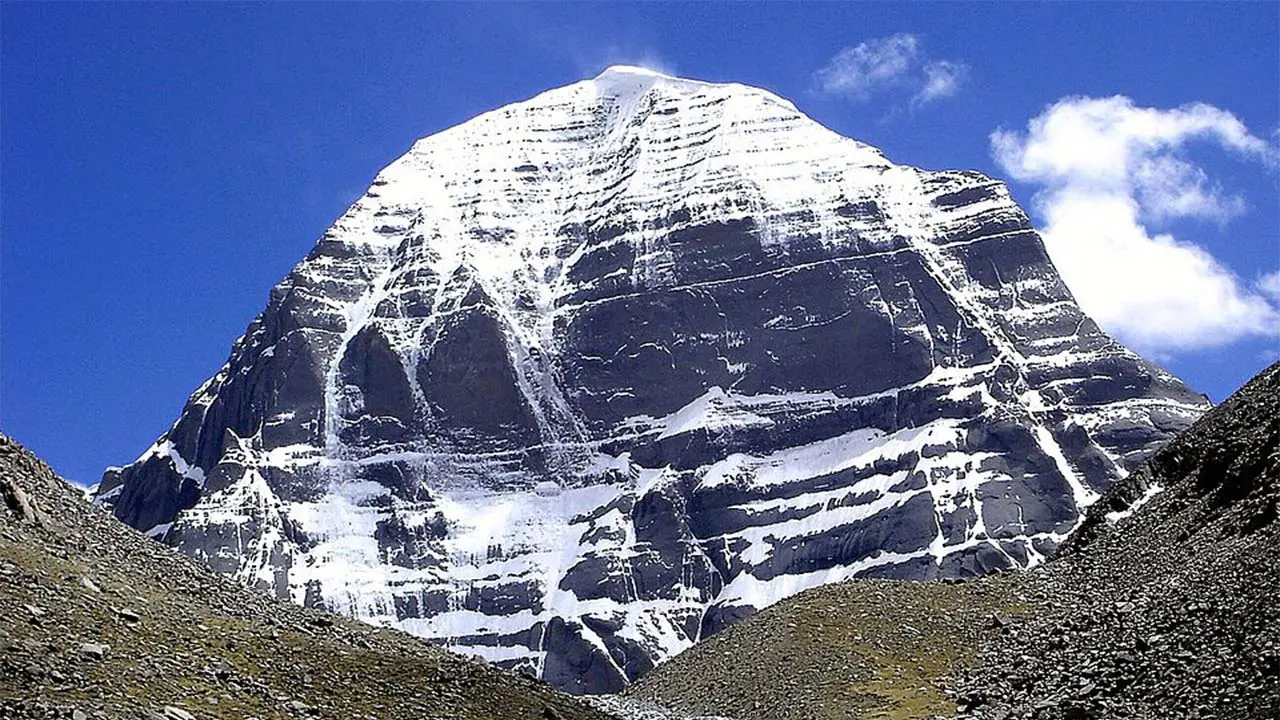
Altitude Sickness Guide for Kailash Mansarovar Yatra
Altitude Sickness or Acute Mountain Sickness (AMS) is a common topic of concern for trekking at higher altitudes above 2500 meters. This sickness can affect anyone, even though the trekker is physically fit and healthy. During this entire Yatra, the Dolma La Pass crossing (5,630m) is the challenging part. At this altitude, the oxygen content in the atmosphere gets lower, resulting in crucial effects such as headache, nausea, dizziness, shortness of breath, fatigue, or even collapse. It is a must to understand the AMS and take proactive measures to enjoy the Kailash Mansarovar Yatra with peace of mind and spirituality. Being informed and prepared for AMS ensures your Kailash Kora trek remains safe and avoids unnecessary health concerns.
Symptoms of AMS – Keep an eye on your trekking partners
- Headache, fatigue
- Nausea or vomiting
- Insomnia or disturbed sleep
- Loss of appetite
- Shortness of breath with minimal exertion
- Dizziness or confusion (severe cases)
Prevention Strategies
- Gradual acclimatization is the key. 1st night in Kerung, 2nd night in Saga before heading to Mansarovar Lake.
- The golden rule of acclimatization: maintain pace, climb high during the daytime, descend to sleep
- Maintain adequate hydration – this is the mantra to staying fit during the yatra (3–4 liters of water daily)
- Avoid alcohol consumption
- Avoid cigarettes smoking
- Avoid taking sleeping pills
- Encourage a carbohydrate-rich diet for energy
- Adequate sleep
- Do not pressurize or exert yourself during the day
Medication & Oxygen
- Diamox or Acetazolamide (125–250 mg twice daily) – begin 1 day before reaching 3,000m as a prophylactic if necessary and according to the advice of your physician
- It is always safe to carry portable oxygen cylinders or concentrators
- As natural remedies, you can carry garlic tablets and clove tea (optional)
What to Do If AMS Occurs
- Immediately alert your group leader or trekking guide.
- If any symptoms of AMS worsen or become more severe, descend to a safer, lower altitude immediately.
- Rest as much as possible and hydrate
- Use supplemental oxygen if available
- DO NOT continue the trek if severe symptoms persist
Accommodation and Food on the Kailash Mansarovar Trek with Kora
Talking about accommodation during the Kailash Mansarovar Yatra 15-day, it is basic and functional. There are no luxurious hotels with sophisticated facilities. The accommodations on the way to the Kailash Mansarovar are usually lodges, guesthouses, and accommodations provided by the monastery to help the pilgrims. Basic amenities are only available. These are usually dormitory-style rooms where you can rest a bit and ease up from the demanding high-altitude trek. These accommodations are built in every stop, like Darchen, Dirapuk, and Zuthulphuk. There are mostly shared bathrooms and minimal furnishings in the rooms provided. Room heaters can be an issue, which is why high-quality sleeping bags are recommended to bring along. Here you can lie down and relax your sore muscles to recover from the hectic walks across the rugged landscapes and high mountain passes, such as the Dolma La Pass.
When it comes to meals, please prefer simple, vegetarian meals, which are the main course en route to the Kailash Mansarovar Yatra. It is better for digestion and helps avoid upsetting your stomach. Rice, lentils, soup, boiled vegetables, noodles, bread, tea, or coffee are the usual options included in the menu. Meals are served in the accommodation where you will be staying. Your guide or any kitchen staff will manage your meals as per your preferences. During this Yatra to Kailash Mansarovar Lake, the food menu is very basic. So, you can carry some dry snacks, electrolyte supplements, energy bars, etc. As your trek to Kailash Mansarovar Yatra 15 days package is challenging in every step, it's better to keep your gut healthy and maintain your energy levels, enjoying the spiritual journey.
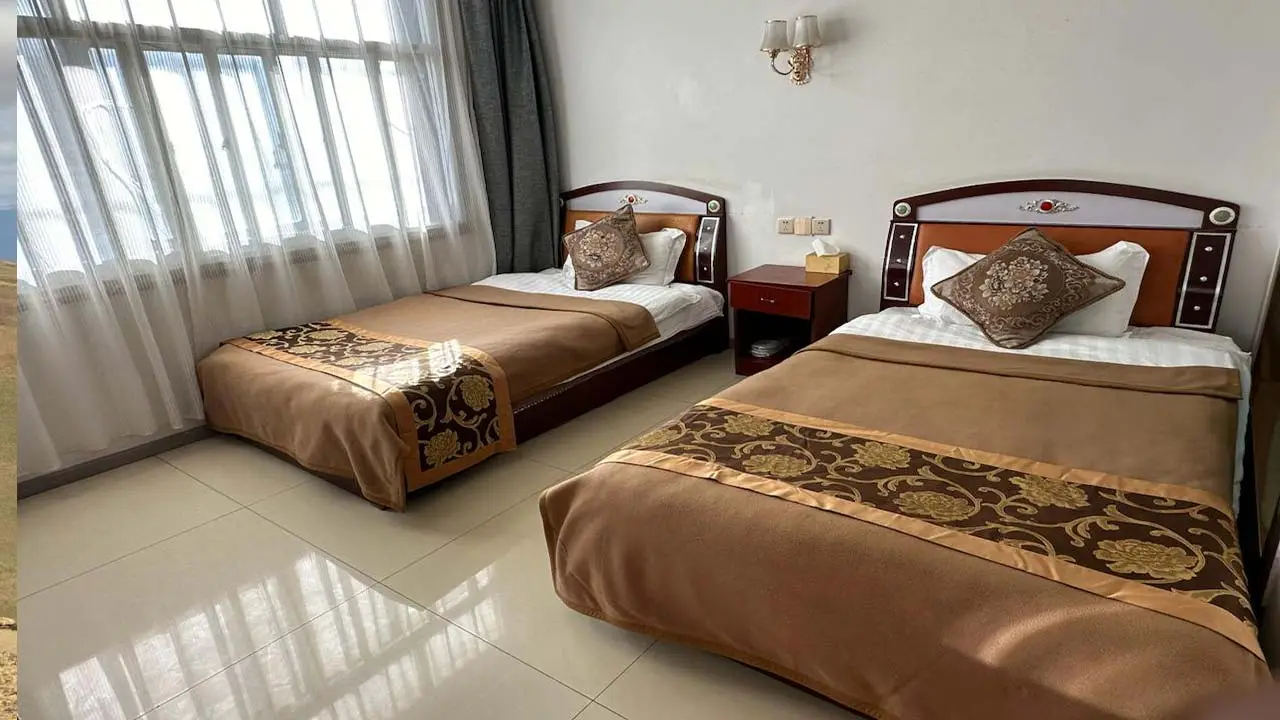
Essential Travel Documents
- Valid passport (minimum 6 months validity) with Tibet group visa
- 4–6 recent passport-size photographs
- Xerox copies of passport and visa (keep in separately)
- Government-issued ID (in case of domestic travel)
- Printed travel insurance with high-altitude coverage
- Emergency contact information
- Flight tickets, booking confirmations
Clothing for Layering
Due to wide temperature fluctuations, layering is key.
- 2–3 pairs of thermal innerwear (top and bottom)
- 1 heavy down jacket (windproof and insulated)
- 2 fleece jackets or warm pullovers
- 2–3 moisture-wicking base layer shirts (quick dry)
- 2 trekking pants and 1 insulated/waterproof pair of pants
- 1 rain poncho or full-body raincoat
- Woolen cap, muffler, and balaclava
- Lightweight sunhat or wide-brimmed hat
- 5–6 pairs of socks (woolen and cotton)
- Lightweight gloves + waterproof outer gloves
Footwear
- Sturdy, waterproof high-ankle trekking boots (well broken in)
- Camp shoes or flip-flops for evenings and toilet use
- Gaiters (optional but helpful in snowy patches)
Toiletries & Hygiene Supplies
- Toothbrush and toothpaste
- Biodegradable soap and shampoo
- Wet wipes and face tissues
- Toilet paper rolls (carry enough for the whole trip)
- Towel (quick-dry travel towel preferred)
- Moisturizers, lip balm (with SPF), and petroleum jelly
- Nail cutter, comb, and sanitary products (if applicable)
Medicines & First Aid Kit
Carry medicines in a waterproof pouch.
- Diamox (acetazolamide) – consult a physician
- Paracetamol, Ibuprofen, or pain relievers
- Cold, flu, and anti-diarrhea medication
- Cough lozenges, nasal spray, sore throat relief
- Antiseptic cream, adhesive bandages, crepe bandage
- Personal prescribed medications
- Eye drops (due to dust)
- Rehydration salts (ORS packets)
- Cotton balls, Q-tips, tweezers
Accessories & Electronics
- Headlamp/torch with spare batteries
- Power bank and universal travel adapter
- Extra memory card for cameras/phones
- Trekking poles (highly recommended for Drolma La Pass)
- Lightweight sleeping bag (rated -10°C or lower)
- Earplugs (for better sleep in group lodges)
- Reusable hot water bottle (optional for comfort)
Food & Supplements
- Dry fruits, trail mix, energy bars
- Instant noodles, soup sachets, and tea/coffee sachets
- Glucose powder or energy drink mix
- Herbal teas or ginger powder (for digestion)
Spiritual Essentials
- Prayer flags, beads (mala), incense (if desired)
- Personal journal or notebook
- Small images or idols for daily meditation
Bags to Carry
- One 40–50L trekking backpack
- One 15–20L daypack for daily use
- Dry bags or waterproof pouches for electronics and documents
Permit Requirements
First thing to understand is that Individual travel to the Kailash Mansarovar region is strictly prohibited. It is essential to apply in advance with all the necessary documents from a registered travel company for a group tour or a private tour. Sometimes, permit processing can take a few weeks. So, please make sure to have a smooth and legally compliant pilgrimage to the sacred Kailash and Mansarovar Lake. The Permit Requirements for Kailash Mansarovar Yatra with Kora are strict and must be obtained before you start your trek. As Tibet is an Autonomous region of China, granting the permit to travelers is politically sensitive. Foreign pilgrims, mainly Indian nationals, are advised to obtain multiple permits for a hassle-free journey.
- Tibet Travel Permit: This permit allows for access to Tibet
- Chinese Group Visa: It is obtained through the Chinese Embassy in Kathmandu, and only authorized travel agencies are allowed to do the visa processing.
- Additional Permits (This area is highly restricted): Mount Kailash Kora (parikrama), a Foreign Affairs Permit, a Military Permit, and an Alien Travel Permit
Group Joining and Private trek
- Group Joining Tour for Kailash Mansarovar Yatra: Looking into budget-friendly options for pilgrims, the Kailash Mansarovar Yatra 15-day tour is the best choice for solo travelers or small groups. There are fixed departure tours tailored by the authorized, government-approved travel companies. This is a complete Yatra package to Kailash Mansarovar that includes permits, transportation, accommodation, meals, guides, and basic medical support. Joining a group reduces your overall cost and creates a good bond of motivation among the pilgrims, which is encouraging during the exhausting trek to Mount Kailash Kora (Parikrama). All the pilgrims surely benefit from the expert trek leaders, well-arranged logistics, and prioritized safe travel in the high-altitude regions. These group joining tours are perfect for those with flexible schedules but want a well-tailored pilgrimage tour; then this is it: Mount Kailash Mansarovar 15-day package.
- Private Trek for Kailash Mansarovar Yatra: Private Treks to Kailash Mansarovar can be arranged as a premium option, mostly for families, friends, spiritual groups, senior citizens, or any travelers with special care and needs. Unlike group tours, the private treks permit only a specific itinerary, preferred travel dates, and adjust the flow of your journey according to your preferences and comfort. You can customize your itinerary as per your demands. The cost for Kailash Mansarovar Yatra taking private treks is higher as compared to the group tours, but you will have full control over the itinerary of your Kailash Mansarovar Yatra with Kora as per your convenience. This private trek ensures a stress-free journey, maintaining the spirituality throughout the sacred landscapes of Mount Kailash and Lake Mansarovar.
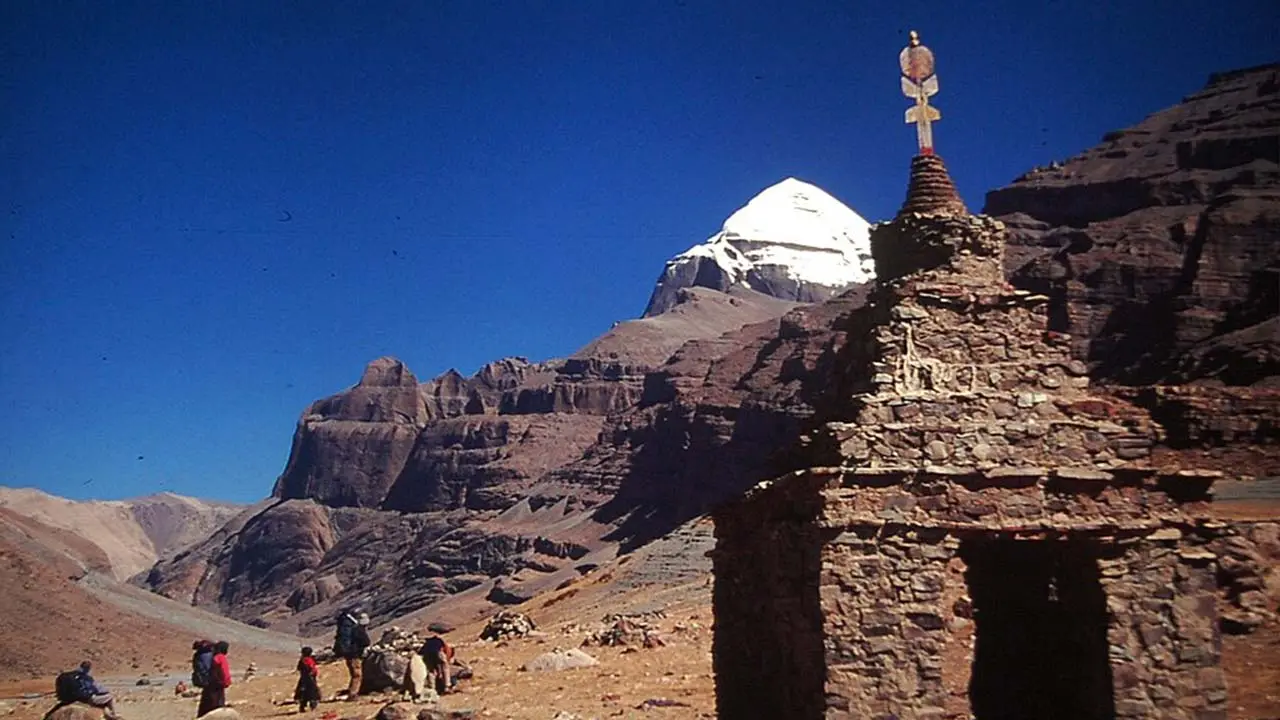
Cost of Kailash Mansarovar Yatra with Kora: Cost Breakdown & Inclusions
The 15-day Kailash Mansarovar Yatra with Kora is a holy trek to the Kailash Mansarovar region with the aim of experiencing the powerful aura of this pious location. For this journey, pilgrims have to traverse the border of Nepal and Tibet to feel the magical, spiritual experience of the nature of Mount Kailash and Lake Mansarovar. Pilgrims travel despite tedious walks to high mountains to feel the divine energy and enjoy the serene beauty of this holy place. Always do the calculations required for the trip before setting off. The key to a successful Kailash Mansarovar Yatra is to make a careful itinerary plan, do the proper budgeting, and select a reputable, trustworthy travel agency like us, Recreation Holidays, that ensures a perfect dream tour, tailoring a perfect Kailash Mansarovar Yatra 15-day package.
Total Estimated Cost of Kailash Mansarova Yatra
The Kailash Mansarovar Yatra cost for the complete 15-day package, including the 52 km Kora, typically ranges from $2,500 to $4,200 per person. The factors affecting the cost variation are group size, route preference, duration of the itinerary, inclusions, and travelling months.
Here is a short breakdown of the cost for the Kailash Mansarovar Yatra package:
International Flights (Not Included in Packages)
- Round-trip to Kathmandu or India: $600 – $900
- Optional helicopter (Simikot–Hilsa): $700 – $1,200
Travel Cost for Kailash Mansarovar Yatra Package (All-Inclusive)
- Overland via Kerung: $2,400 – $2,800
- Helicopter route via Simikot–Hilsa: $3,200 – $4,000
Inclusions:
- Tibet Travel Permit & China Group Visa
- Nepal ground transportation
- Basic accommodations (twin/triple sharing)
- All vegetarian meals (breakfast, lunch, dinner)
- Local guide and trekking support
- Emergency backup vehicle and first aid
- Optional porters/yaks at extra cost
Visa & Permits
- Nepal Visa (foreigners): $30 for 15 days (on arrival)
- Tibet Entry & Restricted Area Permits: Included in package
Accommodation & Meals
- Basic hotels/guesthouses
- Vegetarian meals included
- Limited hot water & electricity in remote areas
Kailash Kora Support (52 km trek)
- Oxygen cylinders & first aid included
- Porters/yaks available (extra cost)
- Emergency support provided
Personal Expenses
- Travel insurance (high-altitude): $50 – $150
- Gear & clothing: $100 – $300
- Snacks, SIM, toiletries: $50 – $100
- Tips & donations: $20 – $50
Pre-Yatra Preparation (Optional)
- Medical check-up & vaccinations
- Altitude sickness meds (e.g., Diamox)
- Fitness training & spiritual prep: $50 – $150
Budget Tips for Pilgrims
- Always choose group departures to reduce the overall costs
- The overland route is more budget-friendly than the helicopter route
- Book early in advance for better visa processing and availability
- Ensure your travel package for Kailash Mansarovar Yatra includes all permits and oxygen support
- Carry minimal cash in local currency and essential items only.
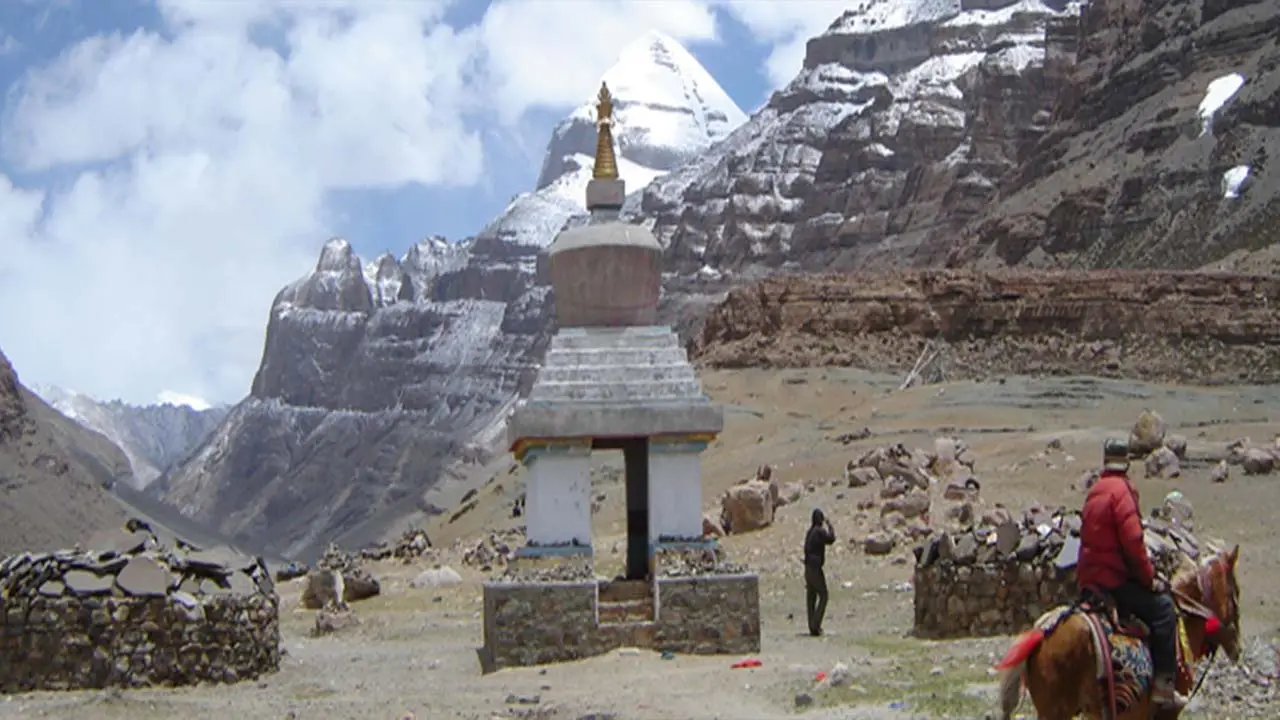
Why Choose Road Trip Yatra for Kailash Mansarovar Yatra by Road- Kathmandu & Delhi?
- Easy altitude acclimatization
- Safe for senior citizens and first board high-altitude trip
- Non-stop immersion in the rich cultures of Nepal and Tibet
- Perfect for groups, families, and spiritual seekers
Road Trip Kathmandu Kailash Mansarovar Yatra
An overland pilgrimage from Kathmandu to Kailash Mansarovar Yatra through the Rasuwagadhi-Gyirong border, and ends very deep into the Tibetan plateau. Experience the calm during this entire route of about 14 to 15 days, where you get to experience dramatic landscapes from Gyirong, Saga, Lake Mansarovar, and finally to holy Mount Kailash for the sacred Kora (parikrama).
Highlights:
- Easy altitude acclimatization
- Picture-perfect, thrilling drives through the Himalayan landscapes
- Sacred sites-Mansarovar, Yama Dorr, Derapuk, Zuthulpuk
- Culturally rich experience from both Nepali and Tibetan
Accrued Estimated Cost: INR 225,000 – 255,000 (USD 2,700-3,100).
Cost Inclusions:
- Transportation (Kathmandu-Kailash-return)
- Accommodation in hotels, guesthouses & lodges
- Veg meals (breakfast, lunch, dinner)
- Chinese visa & Tibet travel permits
- Professional Tibetan & Nepali guides
- Medical backup with an oxygen cylinder
- Travel kit: duffle bag, jacket, cap
- Optional add-ons: yak/porter/horse during the Kora Journey
Road Trip from Delhi to Kailash Mansarovar Yatra
This 15-day overland Kailash Mansarovar Yatra makes Delhi pilgrims travel to Kathmandu (by flight or road), and afterward follows the same spiritually enriching route through Nepal and Tibet. Those who want to experience a more complete journey from India entirely will enjoy this travel arrangement.
Highlights:
- A Delhi trip to a land of the Gods
- A touchdown stop in Kathmandu with temple visits (Pashupatinath)
- Full Overland Yatra with incremental altitude gain
- Access to top spiritual destinations on the route
Estimated Cost: INR 235,000 - 265,000 per head
Cost Inclusions:
- Transport from Delhi to Kathmandu, either by road or air
- Stay and do local sightseeing within Kathmandu
- Full road journey to Mount Kailash Mansarovar
- Hotels, lodges, and basic guesthouses
- Meals throughout the journey (veg)
- All Tibet entry permits & visas
- Team of expert guides, cooks & medical support
- Optional add-ons: yak/horse/porter for Kora trek
- Travel insurance & emergency backup (recommended)
***Contact us right away if you would like to customize your Kailash Mansarovar Yatra by road. Whether you start from Kathmandu or Delhi, we ensure that every pilgrimage experience has a spiritual value, safety, and a well-remembered journey for the pilgrim.
Kailash Mansarovar Yatra Route Map and Altitude Profile
The most common and easiest way of travel for Kailash – Mansarovar Yatra is through Nepal (Kathmandu → Kerung → Saga → Darchen). The final stage, the Kora, consists of a 52 km circumambulation (parikrama) around Mount Kailash.
For one, the route map and altitude profile will be of great help in one's physical preparation and acclimatization to the altitude while planning the itinerary.
General Route Overview-Nepal-Tibet Overland
|
Location |
Approx. Altitude (meters) |
Key Highlights |
|
Kathmandu, Nepal |
1,400 m |
Starting point, visa processing |
|
Syabrubesi |
2,380 m |
Road trip start, overnight stay |
|
Rasuwagadhi (Nepal Border) |
1,800 m |
Nepal-China border crossing |
|
Kerung, Tibet |
2,700 m |
Acclimatization stop |
|
Saga |
4,450 m |
Major Tibetan town en route |
|
Lake Mansarovar |
4,590 m |
Holy lake, puja rituals |
|
Darchen |
4,670 m |
Base for Mount Kailash Kora |
|
Deprapuk (Kora Day 1) |
4,950 m |
The first night of the Yatra, a beautiful view of the North Face |
|
Dolma La Pass (Kora Day 2) |
5,630 m |
The highest point of the Kailash Yatra |
|
Juthulpuk (Kora Day 2) |
4,790 m |
Monastery & night halt |
|
End of Kailash Mansarovar Kora (Kora Day 3) |
4,670 m |
Return to Darchen |
Ascent and Descent Summary of Mount Kailash Yatra with Kora (52 km Trek)
|
Day |
Route |
Distance |
Start Altitude |
End Altitude |
Duration |
Difficulty |
Main Highlight |
|
1 |
Darchen → Dirapuk |
20km |
4,670 m |
4,950 m |
6–7 hours |
Moderate |
View of Mount Kailash (The North Face) |
|
2 |
Dirapuk → Zutulpuk via Dolma La Pass |
22km |
4,950 m (ascend to 5,630 m) |
4,790 m |
8-10 hours |
Hard |
Gauri Kund (Sacred lake near Dolma La Pass) |
|
3 |
Zutulpuk → Darchen |
10km |
4,790 m |
4,670 m |
3-4 hours |
Easy |
Completion of the Kora and return to base camp |
Safety, Altitude Sickness, and Emergency Information for Kailash Mansarovar Yatra with Kora
The Kailash Mansarovar Yatra 15-day package is a special, rejuvenating pilgrimage that is spiritually exhilarating and often physically exhausting. Above 5,600 meters, all seriousness is warranted. Therefore, the safety of travelers, a sense of good health, and emergency preparedness are a must during this journey to Kailash Mansarovar Yatra. This is the complete guide for the pilgrim of Kailash Mansarovar Yatra to know about safety during this Yatra.
Safety Tips for Kailash Mansarovar Yatra
Reaching Kailash Mansarovar will be an exciting journey, as it entails traveling through the remote areas of Tibet and the Himalayas, difficult in terms of terrain, with few support facilities, and adverse weather conditions. So remember, "SAFETY FIRST," as it will help you enjoy the trip to the Kailash Mansarovar Region and reduce unnecessary risk factors.
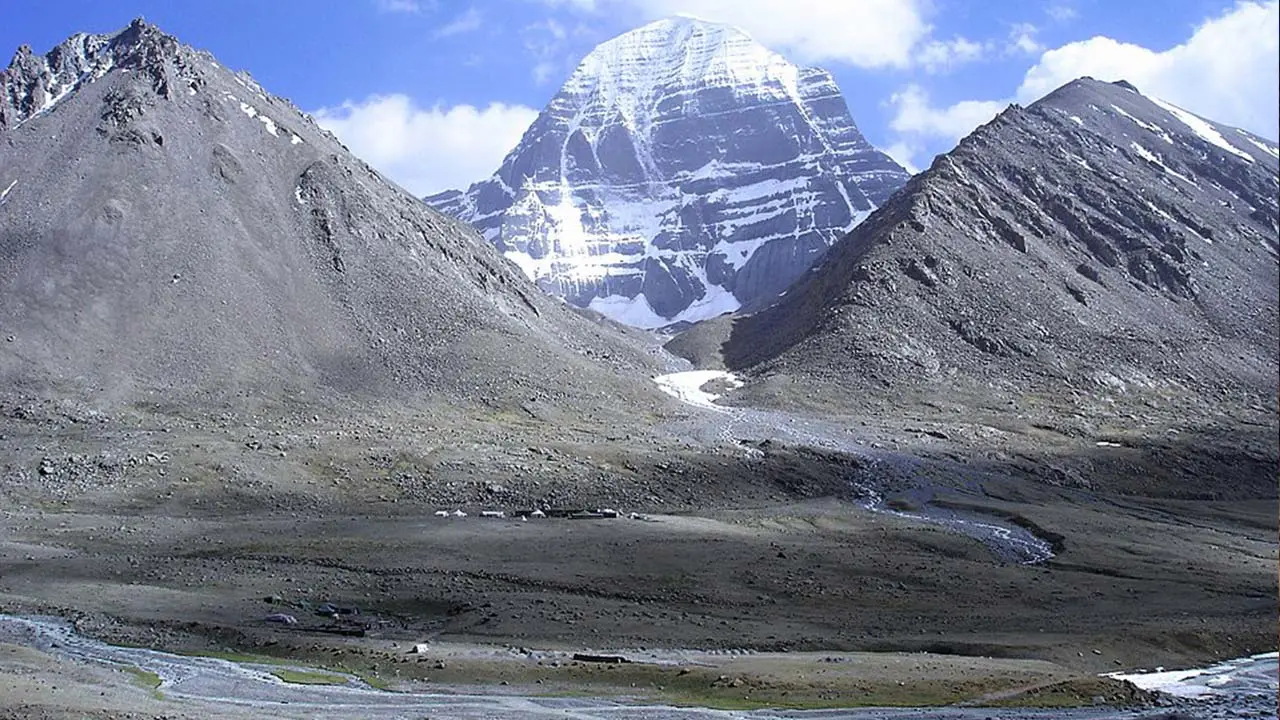
Important Safety Guidelines:
- Chosen Reliable Operator: Confirm that the 15-day Kailash Mansarovar Yatra was organized or operated by a licensed team with reasonable experience offering oxygen support, trained guides, and medical backup.
- Ability to Acclimatize: Stay at least 2-3 days in Kerung or Saga for altitude acclimatization before the Mount Kailash Kora begins.
- Always Travel in Groups: Never trek alone! The power of a group is helpful for each individual, especially in emergencies.
- Respect Local Laws: The Tibetan authorities are extremely strict regarding permits and travel regulations. Always carry them along while travelling with your Tibet Travel Permit and Chinese Group Visa.
- Respect all weather warnings: Sudden snow or a drop in temperature may occur near the Dolma La Pass (5630m), and hence it is always very important to stay alert.
Altitude Sickness on Kailash Mansarovar Yatra
Though all hazards exist, AMS is by far the greatest danger of the Kailash Kora trek due to reduced oxygen availability with increasing altitude. Symptoms begin referring above 3,000 m and become worse after crossing 4,500 m.
Common AMS Symptoms:
- Headache and dizziness
- Nausea and vomiting
- Shortness of breath
- Loss of appetite
- Fatigue or insomnia
Prevention and Management:
- Gradual Acclimatization Halts: 2 complete nights' halt at layover towns like 1st night in Kerung (2,700 m) and 2nd night in Saga (4,450 m)
- Hydration should always be maintained: A minimum of 3-4 liters of water daily to facilitate the flow of oxygen.
- Take light, high-energy foods: High-calorie vegetarian meals that are easy to digest.
- Avoid the consumption of alcohol and smoking: The above will lower the flow of oxygen and worsen AMS symptoms. So, better to avoid alcohol consumption and smoking.
- Take medicines under prescription as per advice of your doctor: Always carry Diamox (Acetazolamide) or other pertinent preventive drugs your doctor has custom-tailored into your treatment plan.
Emergency Protocols & Rescue Options for Kailash Mansarovar Yatra
There could be emergencies at any time, and sometimes, despite all being done to avert such contingencies, one finds oneself in just such emergencies now and then. In the Kailash Mansarovar Yatra, emergency evacuations, if any, are medical evacuations.
Emergency Support & Infrastructure
- Oxygen Cylinder & First Aid: Throughout the entire journey, portable oxygen, pulse oximeters, and first-aid kits are provided by well-established and reputable operators.
- Back-Up Emergency Vehicle: Back-up emergency vehicles are stationed at key points along the Kora route.
- Helicopter Evacuation (Nepal Side Only): An emergency airlift may be arranged to Nepalgunj or Kathmandu for guests using the Simikot-Hilsa helicopter route.
- Chinese Medical Access (Tibet Side): In the remote areas of Tibet, access to medical care is quite basic. Critical patients are airlifted to hospitals in Lhasa or to Nepal from there.
Must-Haves for Emergency Contact Details
- Either carry a satellite phone or get a local SIM card (Chinese SIMs work in Tibet; Nepal SIMs don’t).
- Keep your emergency contact info, insurance, and blood group nearby.
- Inform your guide immediately if you feel sick or start to show signs of AMS.
Major Safety Precautions:
- Travel Insurance: Always take insurance for travel to high altitudes like Kailash Mansarovar Yatra 15 days that covers treks over 5,000m and emergency evacuation.
- Spiritual Preparation: Before leaving for the trek, do puja, such as visiting Pashupatinath Temple, to keep your mind and emotions grounded.
- Listen to Your Body When It Tells You to: If you feel impaired or uneasy in any way, do not force yourself to keep up with the speed. This pilgrimage is about the grace of God and not about speed.
Cultural Insights for the Kailash Mansarovar Yatra with Kora of 15days
The Kailash Mansarovar Yatra, 15 days, which can be called a trek, is a priceless spiritual journey into Tibet through high Himalayan passes. This sacred avenue is aglow in the cultural ambience of centuries-old acts of devotion and pilgrimage sustained by Hindus, Buddhists, Jains, and Bon-pos in their own words.
Sacred Significance across Faiths of Kailash Mansarovar Yatra
- Hinduism: It is said to be the heavenly seat of Lord Shiva. There is a 52 km Kailash Kora (or parikrama) around Mount Kailash, believed to wash away all sins and ensure moksha (spiritual liberation). This is one of the holiest lakes in existence. According to Hinduism, Mansarovar was created by Lord Brahma himself from his mind for ritual bathing and meditation.
- Buddhism: For Buddhists, Kailash is the residence of Demchok (Chakrasamvara), the deity of exhaustive utmost bliss. Pilgrims circle the mountain during Kora in a clockwise direction, chanting mantras, spinning prayer wheels, and some even doing full-body prostrations. This land is particularly associated with Guru Rinpoche (Padmasambhava) and Tibetan saints.
- Jainism: Kailash, called Ashtapada here, is the site where Rishabhadeva, the first Tirthankara, attained Nirvana.
- Bon Religion: Within Bon philosophy, Kailash stands for the spiritual seat of Shenrab Miwoche. Counter-clockwise Kora is walked only by Bon followers, in stark contrast to all other pilgrims.
Rituals and Spiritual Practices
- Kora Trek (52 km): A sacred walk symbolic of karma cleansing and inner transformation.
- Holy Dip in Mansarovar Lake: Said to be the greatest purification of sins.
- Chanting of Mantras & Lighting of Butter Lamps: Done commonly near holy places like Dirapuk Monastery and Zutulpuk Monastery.
- Prayer Flags & Mani Walls: Colorful prayer flags dance in the wind, sending blessings; mani stones bear sacred engravings, such as Om Mani Padme Hum.
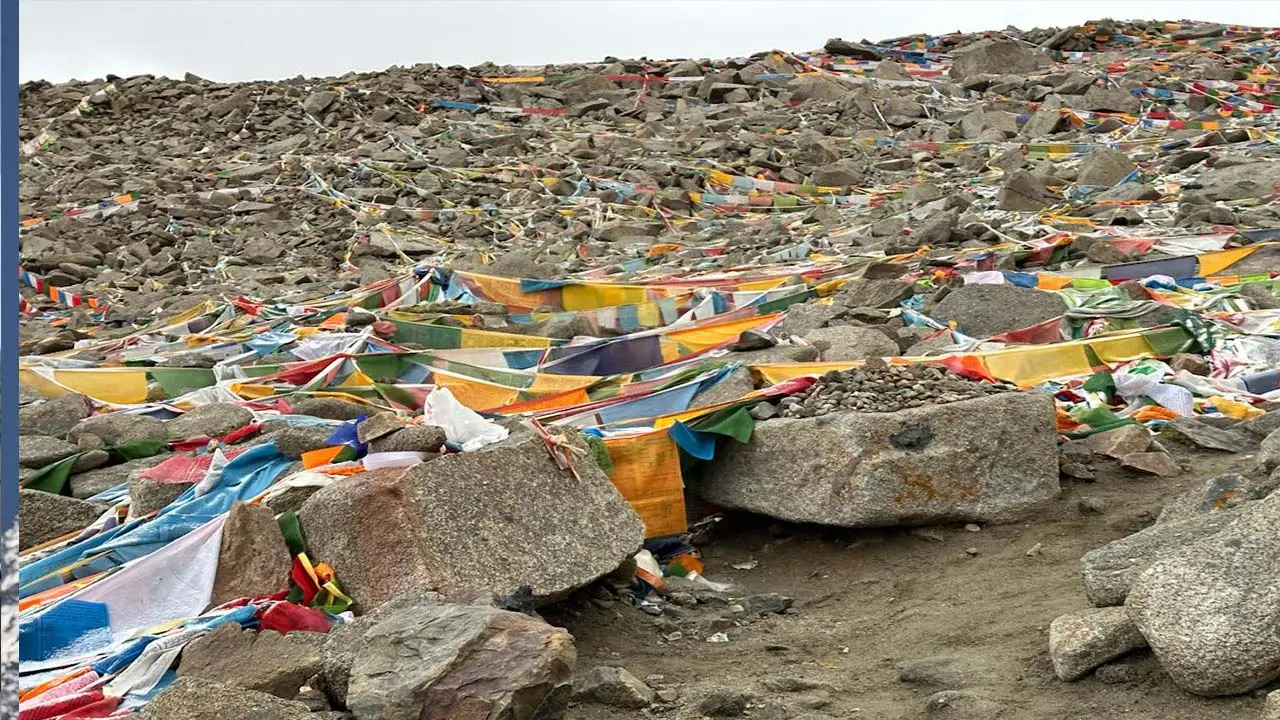
Cultural Etiquettes & Travel Tips:
Always respect and mention local customs as a way to mark down landmarks that were worth noting in completing your journey of Kailash Mansarovar Yatra with Kora
- Dress modestly: An added advantage is long sleeves in light shades while at holy places.
- Respect Photo Rules: Always obtain permission for every snap taken near monasteries and during rituals.
- Stick to the Right Kora Direction: Do not walk against the common way. For Hindus and Buddhists, it is always the Clockwise direction, while for Bon pilgrims, it is the Counter-clockwise
- Be Culturally Aware: Respect every pilgrim, monk, and local person-as they may not follow the faith you do.
Cultural Landmarks on the Route of Kailash Mansarovar Yatra
- Dirapuk Monastery: The resting place on Day 1 of Kora with breathtaking views of the north face of Mount Kailash.
- Zutulpuk Monastery: The sacred cave of Milarepa, Tibetan yogi and poet.
- Chiu Monastery: Built over Lake Mansarovar, associated with the legend of Guru Rinpoche.
- Local Tibetan Villages: Meet warm nomadic herders and pilgrims who keep alive Tibet's ancient highland culture.
Booking Reservations and Customization Guidance for Kailash Mansarovar Yatra
- In planning for the Kora Kailash Mansarovar Yatra, one must be prepared fairly in advance as there are seasonal access, high demands, and adverse travel regulations that inhibit travel. Recreation Holidays offers flexibility and customized booking options just for you, allowing you to travel and enjoy yourself without worrying about any concerns related to your pilgrimage, accompanied by spiritual experiences.
Booking Your Kailash Mansarovar Yatra
- Book Early: Limited permits and limited group sizes require booking for travel 2-3 months in advance.
- Choose Your Route: Depending on your personal preferences for time, budget, and fitness, decide between the Overland route via Nepal or the Helicopter route via Simikot-Hilsa.
- Submit Required Documents: Required documents to travel on Kailash Yatra: Passport (6+ months' validity). Health clearance. Passport-sized photo.
- Visa & Permits: We will obtain the necessary visas and permits for you, including your China Group Visa, Tibet Travel Permit, and local permissions.
- Pay Deposit: Secures trip with deposit; pays full amount before departure.
Custom Kailash Yatra Options
- We offer ''customized pilgrimage experiences'' for solo travelers, families, or spiritual groups. Your journey of Kailash Mansarovar yatra should be tailored according to your pace or comfort levels and, of course, your spiritual needs.
What you can customize for Kailash Mansarovar Yatra:
- Private Tours: For sheer seclusion on those holy days or family groups preferring not to be seen by anybody else. Otherwise, important add-on tours: Pre-or post-Yatra visits to either Pashupatinath, Muktinath, or Lumbini. Add acclimatization days to ease changing heights. Comfort upgrades, better hotels, hot showers, or porter/yak support during Kora are requested.
- Special Meals: vegetarian, vegan, Jain, or medically required diets.
Booking Tips for Pilgrims
- Check Inclusions: Check if permits, daily meals, lodging, oxygen, and emergency support are included in your package.
- Review the Itinerary: Ask for detailed day-by-day plans indicating the respective altitudes.
- Obtain Travel Insurance: A plan that would include high-altitude trekking and emergency rescue would thus be able to provide protection.
Fly-Back Options for Kailash Mansarovar Pilgrimage via Helicopter
Choosing a helicopter return route for your Kailash Mansarovar Yatra provides added comfort, time savings, and a smoother descent, especially after the physically demanding Mount Kailash Kora trek. These packages combine road and air transport, making them especially suitable for elderly travelers, time-bound professionals, and those with altitude sensitivity. Be sure to book early and confirm availability with your travel operator for a hassle-free spiritual journey.
Why Choose the Helicopter Return Route?
The helicopter-assisted Kailash Yatra reduces long hours of road travel and allows for quicker access to remote border regions. While the outbound journey typically follows the standard overland route via Kerung, the return is made easier and faster by helicopter from Hilsa or Simikot back to Nepalgunj or Kathmandu.
Popular Helicopter Return Itinerary
- Travel by road from Darchen to Hilsa, passing through Taklakot (Burang)
- Take a short helicopter flight from Hilsa to Simikot
- Board a scheduled domestic flight from Simikot to Nepalgunj
- Optionally, fly from Nepalgunj back to Kathmandu
- This combination reduces days on the road and helps pilgrims descend quickly to lower altitudes after completing the Kora.
Benefits of Helicopter Return on Kailash Yatra
- Time-Efficient: Saves 2–3 days compared to the full overland return route.
- Altitude Relief: It quickly brings you down from high-altitude regions, reducing the risk of AMS.
- Elder-Friendly: Ideal for senior citizens or those with limited physical endurance.
- Flexible Packages: Many tour operators now offer one-way helicopter return options with fixed departure dates.
Cost Considerations for the Helicopter Return Packages
Helicopter return packages are typically priced higher than standard overland tours due to the inclusion of chartered or shared flights. However, for many pilgrims, the added cost is outweighed by the convenience and physical comfort.
Estimated extra cost: $600–$1,000 per person, depending on flight availability, weather conditions, and tour operator.
Things to Remember
- Weather Dependent: Flights from Hilsa and Simikot are subject to weather delays; buffer days are recommended.
- Weight Limits Apply: Limited baggage allowance on helicopters (typically 10–15 kg per person).
- Advance Booking Required: These seats are limited and must be confirmed well in advance.
Travel Insurance, Health & Emergency Rescue for Kailash Mansarovar Yatra with Kora
Undertaking the Kailash Mansarovar Yatra with Kora is a life-changing spiritual journey, but it also involves high-altitude trekking, remote terrain, and limited medical infrastructure. That’s why proper travel insurance, health preparation, and emergency rescue support are crucial for a safe and stress-free pilgrimage.
Importance of Travel Insurance for Kailash Yatra
Travelers are strongly advised to purchase high-altitude travel insurance that specifically covers:
- Trekking above 5,000 meters
- Emergency medical evacuation (helicopter rescue)
- Trip delays or cancellations
- Baggage loss or damage
Make sure your policy includes evacuation from remote regions like Simikot, Hilsa, or Taklakot and medical care during high-altitude sickness.
Health Guidelines for Pilgrims
Due to extreme altitudes (up to 5,630 m at Dolma La Pass), pilgrims should undergo pre-yatra health checkups and consult a physician about:
- Altitude sickness prevention (e.g., using Diamox)
- Fitness for strenuous trekking
- Existing heart or respiratory conditions
- Vaccinations and personal medication needs
Staying hydrated, eating light vegetarian meals, and taking adequate rest during the journey helps prevent Acute Mountain Sickness (AMS).
Emergency Rescue & Medical Support
Reliable tour operators include basic emergency support such as:
- Portable oxygen cylinders and pulse oximeters
- First aid kits and health monitoring
- Access to emergency evacuation by helicopter (from Hilsa or Simikot)
- Guides trained in altitude sickness response
In case of severe illness or injury, immediate air evacuation to Kathmandu or Nepalgunj may be arranged.
Internet, Connectivity, and Charging on the Kailash Mansarovar Yatra Trail
Staying connected during the Kailash Mansarovar Yatra with Kora can be challenging due to the remote, high-altitude terrain of the Tibetan plateau. While the spiritual focus of the journey encourages digital detox, many travelers still want access to essential communication, navigation, or emergency contact tools. Here's what you should know about internet availability, mobile connectivity, and power supply along the route.
Mobile Network & Internet Connectivity
- Limited Mobile Signal: Once you enter the Tibet Autonomous Region, your Nepali SIM will no longer work. Only Chinese SIM cards (such as China Mobile) may offer sporadic coverage near towns like Saga, Darchen, and Taklakot.
- No Signal during Kora: Mobile network coverage is generally unavailable during the Mount Kailash Kora trek, especially around Dirapuk, Dolma La Pass, and Zutulpuk.
- Wi-Fi Availability: Some guesthouses in Kerung, Saga, and Darchen may offer limited or paid Wi-Fi, but speed and reliability vary greatly.
Charging Devices on the Trail
- Electricity Access Is Limited: Charging points are only available in guesthouses or lodges at major stops like Kerung, Saga, Mansarovar Lake, and Darchen.
- No Charging during Kora Trek: There are no reliable power sources along the 52 km Kailash Kora, so carry enough backup power.
- Power Cuts Common: Electricity may be limited to a few hours in the evening, and prone to outages due to remote infrastructure.
Recommended Gear:
- High-capacity power banks (10,000mAh or higher)
- Solar chargers for extended use
- Multi-plug adapters and Type A, C, or I plug converters
Tips for Staying Connected
- Inform Family in Advance: Let your loved ones know that you’ll be out of contact during the Kora days.
- Download Offline Maps: Apps like MAPS.ME or Google Maps offline mode can help with navigation when the signal is lost.
- Carry Printed Documents: Keep hard copies of your itinerary, permits, and emergency contacts in case your phone battery dies.
Porter & Guide Services for Kailash Mansarovar Yatra with Kora
Hiring a porter and guide for your Kailash Mansarovar Yatra with Kora can greatly enhance your safety, comfort, and spiritual experience. Given the high-altitude terrain, changing weather conditions, and cultural sensitivity of the region, having experienced local support is invaluable.
Why hire a Local Guide for Kailash Mansarovar Yatra
A knowledgeable Kailash Mansarovar guide is more than just a trail leader—they are your cultural interpreter, safety expert, and logistical coordinator.
Benefits of a Licensed Guide:
- Ensures you stay on the correct Kora route around Mount Kailash
- Provides insights into local culture, monasteries, and spiritual rituals
- Assists in communication with locals and officials in Tibet
- Helps manage altitude symptoms and basic first aid if needed
Most reliable Kailash tour operators include a certified Tibetan guide as part of the package, ensuring compliance with regional travel regulations.
Porter Services for Kailash Kora Trek
The 52 km Kora around Mount Kailash can be physically demanding, especially at altitudes above 5,000 meters. Hiring a porter or yak to carry your backpack or duffel bag helps conserve energy and reduce the risk of altitude-related fatigue.
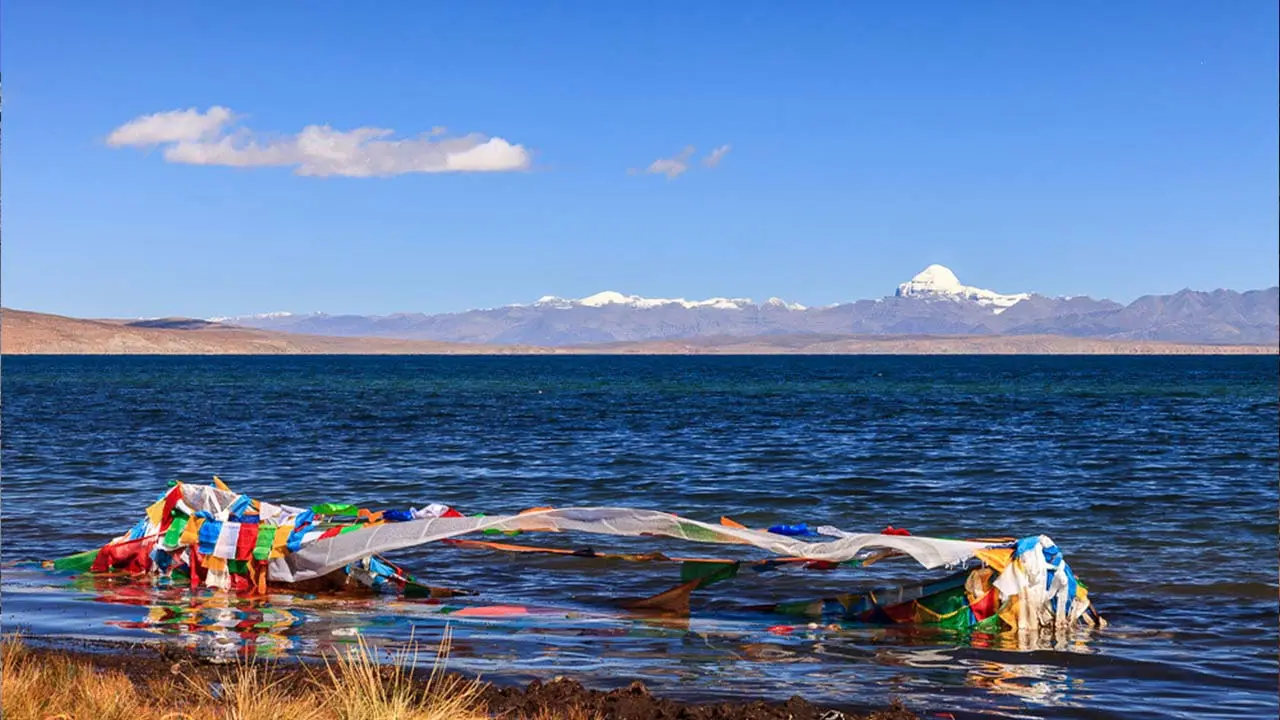
Porter Service Includes:
- Transport of personal belongings (usually up to 10–15 kg per person)
- Option to rent yaks or horses for carrying luggage or in case of physical exhaustion
- Available from Darchen (starting point of the Kora)
Important note: Porters may not speak English, but they are familiar with the trail and experienced in high-altitude trekking.
Cost of Guide and Porter Services
- Guide Fee: Usually included in package tours; solo travelers may pay extra (approx. $25–$40/day)
- Porter or Yak Hire: Ranges from $100–$150 for the full 3-day Kora
- Horse Riding Option: Available for those unable to walk long distances (subject to availability and health conditions)
Customized Kailash Mansarovar Yatra Packages
Many tour operators now offer customizable Kailash Mansarovar Yatra packages to meet the diverse needs of modern pilgrims. Whether you're traveling with family, a senior group, or on a spiritual retreat, you can tailor the itinerary to suit your fitness level, travel dates, preferred route, and accommodation preferences. Options include private group tours, extraacclimatization days, luxury upgrades, and pre- or post-Yatra add-ons like visits to Pashupatinath or Muktinath. Custom packages ensure a more personal, flexible, and comfortable spiritual journey.
Responsible and Sustainable Trekking on the Kailash Mansarovar Yatra
The Kailash Mansarovar Yatra is a heavenly experience, as it is considered the most sacred place in the world, where you feel spiritually uplifted and at peace. The serenity of the surroundings is purely calming in nature. As the number of pilgrims increases each year, it's more important than ever to follow responsible and sustainable trekking practices that protect both the environment and the cultural heritage of the Himalayas.
Pilgrims and trekkers are encouraged to adopt a "leave-no-trace" approach, ensuring that all waste—especially plastics and non-biodegradable items—is carried back or disposed of properly. Using refillable water bottles, eco-friendly toiletries, and avoiding single-use plastics are simple yet powerful steps. Choosing tour operators who follow green practices, such as offering solar-powered charging or biodegradable packaging, contributes to long-term conservation.
Supporting local communities by hiring local guides, purchasing regional handicrafts, and staying in community-run lodges helps sustain the area's economy. Culturally, travelers should respect Tibetan customs, sacred sites, monasteries, and wildlife, refraining from any behavior that disrupts local traditions.
Responsible trekking on the Mount Kailash Kora route not only reduces your ecological footprint but also deepens your spiritual connection with this sacred land. By traveling with care and respect, you contribute to protecting the sacredness and natural beauty of Mount Kailash and Lake Mansarovar for future generations.
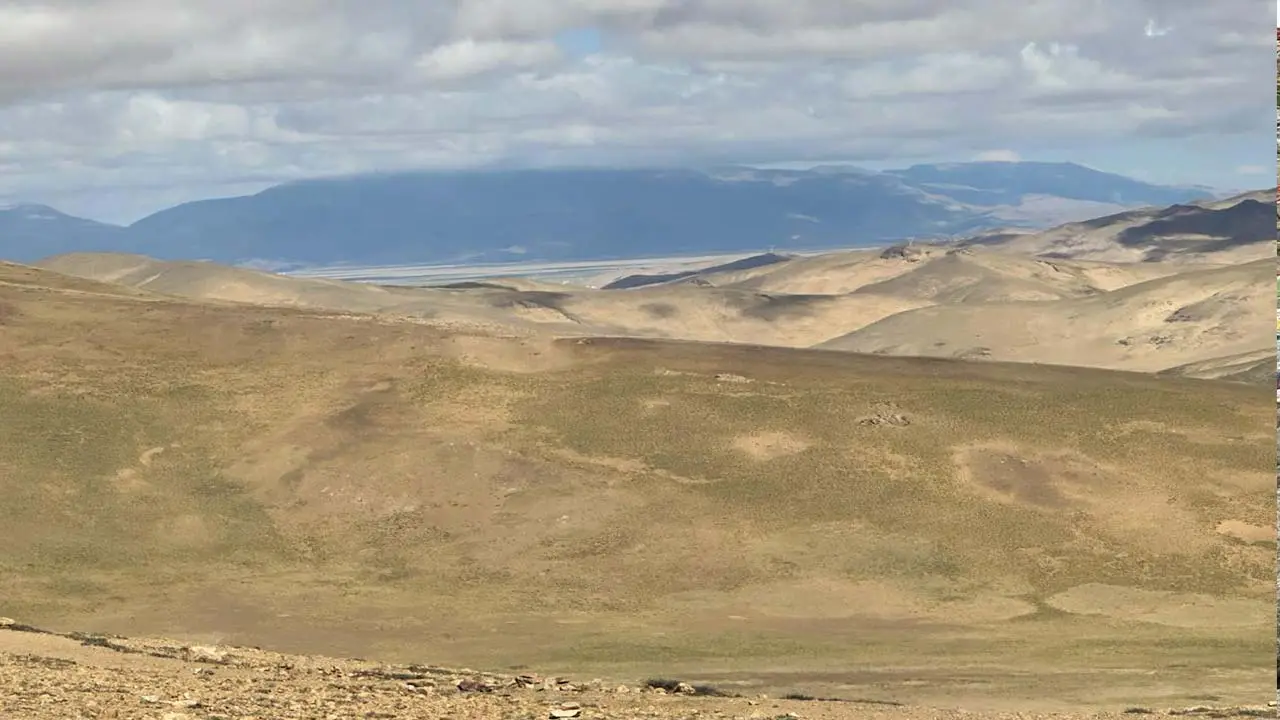
Dos and Don’ts to Follow During the Kailash Mansarovar Yatra
Do’s:
- Dress modestly at all religious sites and during the Kora trek.
- Walk clockwise around Mount Kailash if you follow Hinduism or Buddhism (Bon followers walk counter-clockwise).
- When you meet locals, greet them with respect—a smile or a slight bow is truly appreciated.
- Ask permission before taking photos of people, monks, or religious ceremonies.
- You must remove your shoes before entering monasteries and temples. It's a sign that you pay respect to the holy place.
- Participate respectfully in rituals and prayer ceremonies, even if you are observing.
Don’ts:
- Do not touch the prayer flags or any sacred objects without permission.
- Maintain the peaceful environment of the surroundings. Avoid any kind of loud music or behavior near monasteries or sacred spots.
- Do not litter—carry your waste to help preserve the environment.
- Never point your feet at religious icons or images of deities.
- Do not disturb pilgrims who are meditating or prostrating along the Kora trail.
The Kailash Mansarovar Yatra is conducted under strict local guidelines, and weather or political circumstances may affect services.
The group operator reserves the right to make route changes in case of emergencies or border closures.
Spiritual intentions are at the heart of this journey – we encourage all travelers to come with patience, devotion, and an open heart.
Kailash Mansarovar Yatra 15 Days Package FAQs
The Kailash Mansarovar Yatra with Kora is a holy journey for many pilgrims heading to the giant Mount Kailash and beautiful Lake Mansarovar in Tibet. The pilgrims usually walk a 52 km path to reach the amazing destination surrounded by the tall mountain, called the Kora, which is as an act of devotion. Mainly Hindus, Buddhists, Jains, and Bon followers are the pilgrims to this sacred place.
Mount Kailash is sacred in many religions. Hindus believe it is the home of Lord Shiva, Buddhists and Bon followers see it as the center of the universe, and Jains honor it as the place where their first saint found liberation. Its untouched peak is respected by all.
The Kora refers to the act of circumambulating Mount Kailash, a 52-kilometer spiritual trek at high altitude. Pilgrims believe completing the Kora washes away sins and brings spiritual liberation. Some do one circuit, while others attempt 13 or 108 circumambulations.
The best time for the Kailash Mansarovar Yatra is from May to September, when the weather is relatively stable, and the Tibetan Plateau is accessible. July and August are particularly popular due to the presence of pilgrims and the full moon at Lake Mansarovar.
The Kora is a moderately to highly challenging trek, reaching elevations up to 5,630 meters (18,471 ft) at Dolma La Pass. The high altitude, rough paths, and changing weather mean you must be physically prepared for fit enough for this trek.
The entire Kailash Mansarovar Yatra, including travel and acclimatization, typically lasts 12 to 16 days, depending on the route. The Kora trek itself takes 2–3 days, depending on your pace and physical condition.
Yes, international pilgrims require a Chinese visa and a special Tibet Travel Permit to enter the Tibet Autonomous Region. Group permits are usually arranged by authorized travel agencies handling Kailash Mansarovar tours.
Yes, Indian nationals can join through either the MEA (Ministry of External Affairs) route or private travel operators. Both routes require medical fitness, proper documentation, and security clearance.
Yes. Due to the extreme elevation, Altitude Mountain Sickness (AMS) is a serious concern. It's important to be fit, stay hydrated, and adapt to the high altitude. Some travelers take Diamox or oxygen support under medical guidance.
Yes. Generally, travelers above 65 years or with chronic illnesses (heart, asthma, or hypertension) are advised not to participate. A medical certificate and fitness approval are mandatory before joining the trip.
Accommodation ranges from basic guesthouses and monasteries in Tibet to tented camps near the Kora route. In remote areas, facilities are limited, with shared toilets and no hot water, so travelers must be mentally prepared for rough conditions.
No. Independent travel in Tibet is not permitted. All pilgrims must travel in organized groups through authorized agencies with valid permits, guides, and logistics support.
Absolutely. The journey is considered a once-in-a-lifetime spiritual experience. Pilgrims return with a profound sense of peace, purification, and inner transformation, having walked in the footsteps of saints and sages across millennia.
Yes, the Yatra is open to travelers aged 12 to 70 years. Those nearing 70 are strongly advised to undergo a comprehensive medical check-up before participating. Good health for all travelers is needed to handle the changes while on a high-altitude trek.
Travelers’ Review
I am from India and a devoted follower of Lord Shiva. As we all know, Mount Kailash is considered the divine abode of Lord Shiva—a sacred...
I am originally from India but currently living in the UK. My entire family comes from a devout Hindu background, and we are all strong devotees of...
I recently completed the Kailash Mansarovar Yatra with Recreation Holidays, and the entire experience was spiritually enriching and professionally managed.
From the moment I booked their Mount Kailash Tour Package,...

